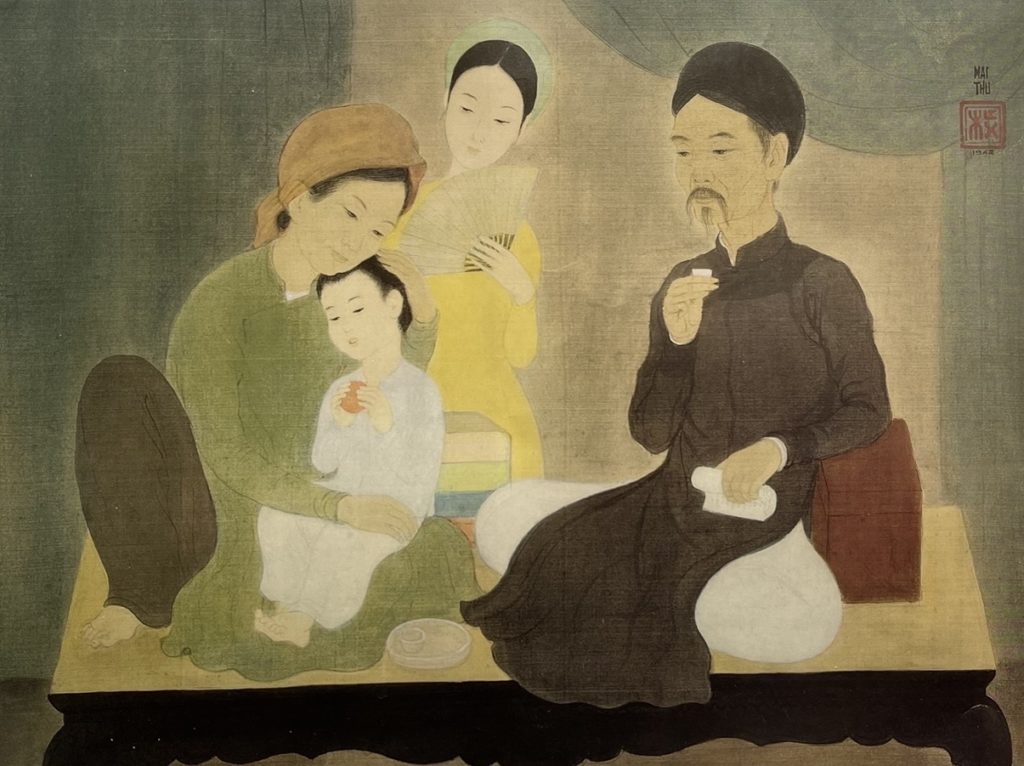Mai Trung Thu, 1942, “The Family” or the pretext of Confucianism
This large (46 x 60 cm) and beautiful gouache and ink on silk belongs to a series of works created by the artist during the German occupation in France. In 1942, after his demobilization (1940), the painter lived in Macon from where he used to visit his friends Le Pho, Vu Cao Dam and Le Thi Luu while in vacation on the French Riviera.
Unlike his best friends Le Pho and Vu Cao Dam, Mai Thu does not seem to be attracted by the Western style. By the Western world yes (he assumed his choice in 1937), but the Western style? He preferred, in each of his works, to refer to the foundations of his own culture of origin. Imbued with the classical Vietnamese culture, excellent traditional musician, he embodies, in fact, the classical Confucian scholar sometimes tinged with Taoism.
The work represents a scholar and his family gathered on a kang, a Chinese-style bed, made of hard wood and covered with a fine mat. Draperies in the background underline the comfort of the place.

All eyes are on the child.
The man, probably the grandfather, is drinking tea or alcohol from a small cup. Another cup, identical, rests on a bowl placed on the bed.
White and black construct the space: the immaculate white – the man’s pants, the child’s trousers, the letter, the cups, the bowl – seems to be the chromatic pivot of the painting. The black ink used for the hair of the four protagonists and the bed. The scene is constructed in two triangles, the one formed by the brown color of the woman’s pants on the left, the pillow on the right and the man’s tunic highlighting the one created by the soft colors of the group of two women and the child.
Support and tenderness. Pose and certainty.
The man’s long nails, his look, his grip on the cup, the his tunic well set sign his scholar’s status. The old lady hugs the little boy – probably her grandson eating a treat. Behind them, a young woman, dressed in the traditional ao dai, with her Tonkinese headdress, probably the older sister or the mother, observes, a little distantly, the grandmother while using a fan.
No effusiveness, distance. No smiles. Any emotion would be indecent. Social austerity as a mantra.
Two observations in the light of this painting:
Mai Thu’s style was already fixed in the 1940s. His paintings, in theme and technique, will be the same until the death of the painter in 1980. Only the Vietnam War (“The New Dawn“) will see him turn away from his polite characters, children or adults, bathed in Confucianism.
With Mai Thu, there is no “Romanet period” or “Findlay period” as with Le Pho, no change of medium as with Vu Cao Dam, who carried out fruitful research in this field in the 1950s. No internationalization of his work with a Findlay contract, viaticum for America.
This freeze shows that if he crossed a geographical border, it was not a mental border. Physically, intellectually and professionally Mai Thu is in France (“La Joconde“, “Nue” or “La Belle Odalisque”), but mentally he remained in Vietnam.
Probably because of his head strong “Young Lady of Hue“… But we will never know.
After all the painter had the right, wherever he was, to follow Nguyen Binh Khiem (1491-1587) (Bach-vân quôc-ngu thi, poetry XXIII):
“I do not forget the ancient feelings of love of the country and devotion to the prince
But on today’s affairs I am reluctant to decide on the true and the false“.
For Mai Thu, Confucianism is a pretext, the one to have the choice not to choose.
Jean-François Hubert